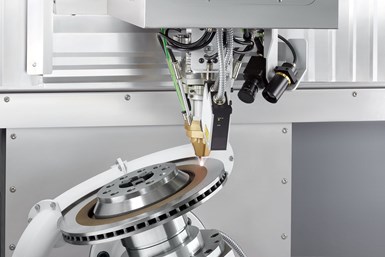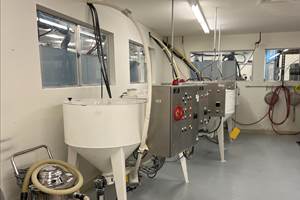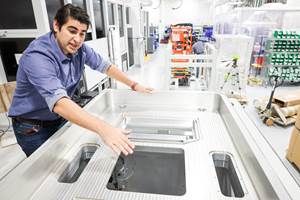Chiron’s High-Speed Additive Manufacturing Coating for Brake Discs
The process offers advantages over thermal coating with high-velocity flame spraying — the brake discs don’t need to be pretreated and the process is significantly faster.
Process advantage for a high coating speed: The powder particles already melt in the laser beam. Photo Credit: Chiron
Chiron Group’s additive manufacturing (AM) coating is an industrial system designed for 24/7 operation for applying extremely hard coatings to brake discs. The company says the protective layer is applied onto the brake disc faster and better, while also staying on longer.
“The solution is intelligent coatings, which we can apply with our AM Coating system,” says Dr. Geza Koscsak, head of AM at the Chiron Group. In his previous position as head of Chiron’s predevelopment, he was significantly involved in the development of the system and the decision in favor of the high-speed buildup welding process.
With high-speed laser metal deposition (LMD) welding, the powder particles cover a longer distance than with conventional LMD processes before they are deposited. In this way, they can absorb more energy and already melt in the laser beam, which enables a significantly faster coating speed. The process also has a clear advantage over thermal coating with high-velocity flame spraying: the brake discs do not need to be pretreated and the process is significantly shorter.
The higher speed and shorter process are two advantages that AM Coating offers. It will also have an added advantage in relation to the future Euro 7 standard. “When the standard comes — and it will definitely come — then a production volume of 10 million brake discs per year will have to be managed for the European vehicle brands alone,” Dr. Koscsák says. “With a cycle time of around 30 seconds per disc for classic brake discs, it is clear that the coating process has to keep up.”
The AM Coating is available in two versions: AM Coating Twin and Single. The AM Coating Twin is for series production. The system works with two lasers for the front and rear coating, with the fully automatic transfer of the brake discs. AM Coating Single is well suited for anyone who wants to test materials and material combinations in parallel with series production or, in advance, develop the application process or produce small series.
On request, the Chiron Group’s team of experts will provide support for process development, either at the customer’s site or in Tuttlingen. Chiron can install a machine on which the customer’s specialists can get to know the process, run tests and work with Chiron specialists to design the parameters ready for series production or for a consistent and even more productive process.
According to the company, the coating is durable and resists cracking. “Using high-speed laser deposition welding, we achieve improved adhesion through a material connection. In addition, the layer thickness is less, it is in the range of tenths of a millimeter,” says Ernest Frombach, Chiron project manager. “This means that much less material is used and, thanks to our powder management, we achieve a high degree of powder utilization. Buffer and hard material layers are applied directly one after the other. With the application of the first layer, the brake disc is tempered, so to speak. We consistently achieve the best application quality, brake disc for brake disc, without the formation of pores or cracks.”
- Listen to episode 27 of The Cool Parts Show to hear how additive manufacturing enables lighter, better-performing brake rotor production.
Related Content
A Tour of The Stratasys Direct Manufacturing Facility
The company's Belton manufacturing site in Texas is growing to support its various 3D printing applications for mass production in industries such as automotive and aerospace.
Read More8 Cool Parts From Formnext 2024: The Cool Parts Show #78
End-use parts found at Formnext this year address various aspects of additive's advance, notably AM winning on cost against established processes.
Read MoreHow AM Enables Cobot Automation for Thyssenkrupp Bilstein (Includes Video)
The shock absorber maker has responded to its staffing shortages through extensive use of collaborative robots. In-house 3D printing makes this possible by providing the related hardware needed to complete the cobot-automated cells.
Read MoreSeurat: Speed Is How AM Competes Against Machining, Casting, Forging
“We don’t ask for DFAM first,” says CEO. A new Boston-area additive manufacturing factory will deliver high-volume metal part production at unit costs beating conventional processes.
Read MoreRead Next
Postprocessing Steps and Costs for Metal 3D Printing
When your metal part is done 3D printing, you just pull it out of the machine and start using it, right? Not exactly.
Read MoreBike Manufacturer Uses Additive Manufacturing to Create Lighter, More Complex, Customized Parts
Titanium bike frame manufacturer Hanglun Technology mixes precision casting with 3D printing to create bikes that offer increased speed and reduced turbulence during long-distance rides, offering a smoother, faster and more efficient cycling experience.
Read MoreProfilometry-Based Indentation Plastometry (PIP) as an Alternative to Standard Tensile Testing
UK-based Plastometrex offers a benchtop testing device utilizing PIP to quickly and easily analyze the yield strength, tensile strength and uniform elongation of samples and even printed parts. The solution is particularly useful for additive manufacturing.
Read More





















